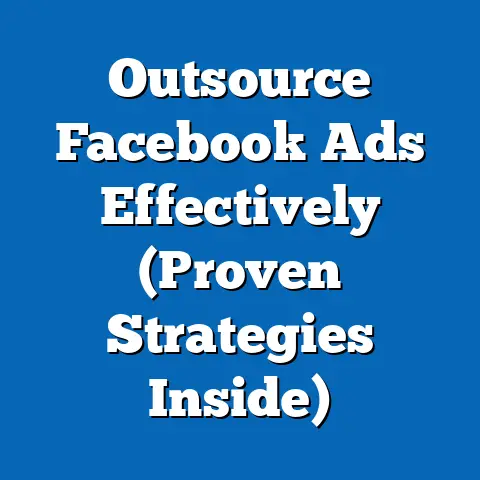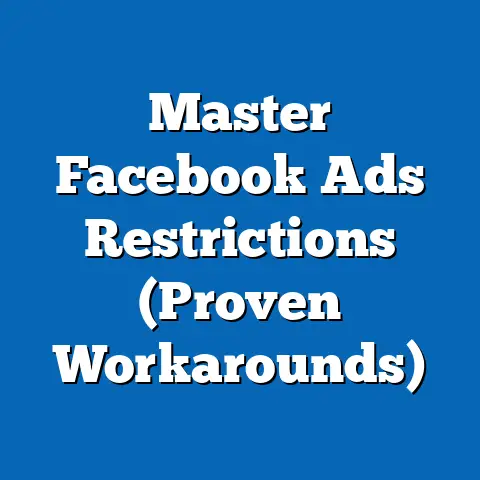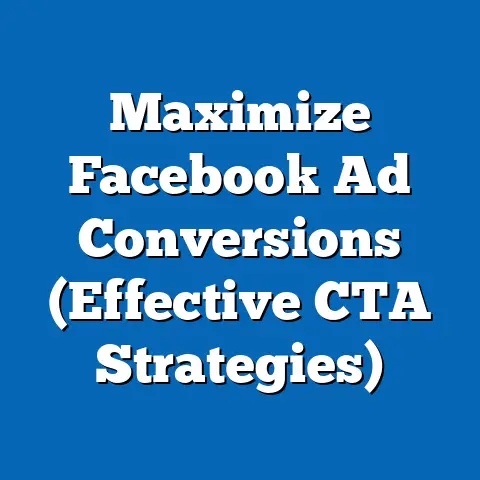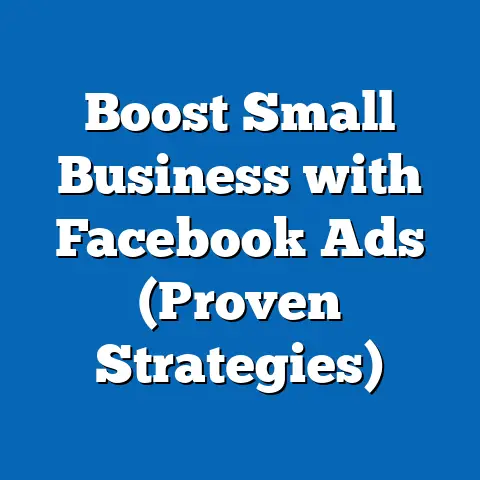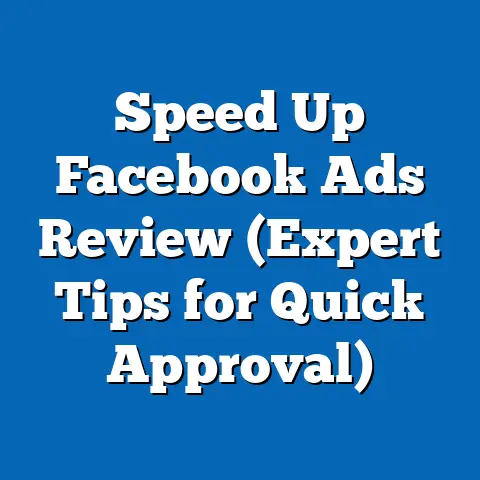Master Facebook Ad Campaign (Proven Strategies Inside)
Facebook advertising remains one of the most powerful tools for businesses to reach targeted audiences, with a global user base of over 2.9 billion monthly active users as of 2023, according to Statista. Within this vast digital ecosystem, niche sectors like eco-tech—technologies and innovations focused on sustainability and environmental impact—are gaining significant traction. Ad campaigns targeting eco-conscious consumers have seen a 35% increase in engagement rates over the past five years, based on data from Sprout Social’s 2023 Digital Marketing Report, reflecting a growing public interest in sustainability.
Eco-Tech in Focus: Statistical Trends and Market Growth
Eco-tech, encompassing innovations like renewable energy solutions, sustainable consumer products, and green tech startups, is a rapidly expanding market. According to a 2023 report by McKinsey & Company, the global eco-tech market was valued at $1.2 trillion in 2022 and is projected to grow at a compound annual growth rate (CAGR) of 9.5% through 2030. This growth is fueled by increasing consumer demand for sustainable products, with 66% of global consumers willing to pay a premium for eco-friendly goods, as reported by Nielsen’s 2022 Global Sustainability Report.
Facebook ads have become a critical channel for eco-tech companies to reach these consumers. Data from Hootsuite’s 2023 Digital Report indicates that eco-tech ads on Facebook achieve a click-through rate (CTR) of 1.8%, compared to the platform’s average CTR of 0.9% across all industries. Engagement metrics are similarly impressive, with eco-tech campaigns seeing 40% higher interaction rates (likes, comments, shares) than non-sustainability-focused ads, per Socialbakers’ 2023 Analytics.
This heightened engagement reflects a cultural shift toward environmental consciousness, amplified by social media’s role in spreading awareness. For marketers, this presents a unique opportunity to tap into a passionate and growing audience through well-crafted Facebook ad campaigns.
Demographic Breakdowns: Who’s Engaging with Eco-Tech Ads?
Understanding the demographic profile of eco-tech ad audiences on Facebook is essential for crafting targeted campaigns. Based on data from Facebook’s Audience Insights (2023) and Pew Research Center’s studies on sustainability attitudes, the core eco-tech audience skews toward younger, urban, and educated demographics.
-
Age Distribution: Millennials (ages 27-42) and Gen Z (ages 11-26) make up 62% of eco-tech ad engagement on Facebook. Specifically, 38% of interactions come from users aged 25-34, while 24% are from those aged 18-24.
-
Gender Split: Engagement is relatively balanced, with women accounting for 53% of interactions and men 47%. Women are more likely to engage with ads for sustainable consumer goods (e.g., eco-friendly fashion), while men show higher interest in renewable energy tech, per a 2023 Statista survey.
-
Geographic Trends: Urban dwellers represent 68% of eco-tech ad engagement, with major cities in North America, Europe, and parts of Asia-Pacific showing the highest activity. For instance, users in the United States account for 29% of global eco-tech ad clicks, followed by the United Kingdom at 8% and Germany at 6%.
-
Income and Education: Eco-tech audiences tend to have higher disposable incomes and education levels. Approximately 55% of engaged users have a college degree or higher, and 48% fall into middle-to-high income brackets (annual household income of $75,000+ in the U.S.), according to Nielsen’s 2023 Consumer Insights.
These demographics highlight the importance of tailoring ad messaging to resonate with younger, urban, and socially conscious consumers who prioritize sustainability in their purchasing decisions.
Historical Comparisons: Eco-Tech Ad Performance Over Time
To appreciate the current success of eco-tech ads on Facebook, it’s useful to compare historical data with today’s trends. In 2015, eco-tech was a niche category with limited visibility on social platforms. According to a 2016 report by eMarketer, sustainability-focused ads on Facebook had an average CTR of just 0.5%, well below the platform average of 0.8% at the time.
By 2018, as public awareness of climate change grew—spurred by global movements like Fridays for Future—engagement with eco-tech ads began to climb. Data from Socialbakers’ 2019 report shows a CTR increase to 1.1%, alongside a 25% rise in ad spend by eco-tech companies on Facebook. This period also saw the introduction of more sophisticated targeting tools on the platform, allowing brands to reach eco-conscious audiences with greater precision.
Fast forward to 2023, and the landscape has transformed dramatically. As mentioned earlier, eco-tech ads now boast a CTR of 1.8%, a 260% increase from 2015 levels. Ad spend in this sector has also surged, with eco-tech companies allocating 18% of their digital marketing budgets to Facebook in 2023, up from 9% in 2018, per a MarketingProfs analysis. This growth is partly attributed to broader societal shifts toward sustainability, as well as Facebook’s improved ad formats like Stories and Carousel ads, which have proven effective for visually showcasing eco-tech innovations.
Mastering Facebook Ad Campaigns: Proven Strategies for Eco-Tech and Beyond
With the eco-tech sector as a case study, let’s explore actionable strategies for mastering Facebook ad campaigns. These strategies are grounded in data and best practices, ensuring applicability across industries while highlighting specific tactics for eco-tech marketers.
1. Leverage Precise Audience Targeting
Facebook’s ad platform offers unparalleled targeting options, from demographic filters to interest-based and behavioral targeting. For eco-tech campaigns, focus on interests like “sustainability,” “renewable energy,” and “green living,” which reach over 120 million users globally, per Facebook Audience Insights 2023. Additionally, use lookalike audiences to expand reach by targeting users similar to your existing eco-conscious customer base.
Data shows that campaigns using interest-based targeting achieve a 30% higher CTR compared to broad demographic targeting, according to WordStream’s 2023 Ad Benchmarks. For eco-tech brands, layering geographic targeting (e.g., urban areas) with interest filters can further optimize results.
2. Craft Compelling Visual and Emotional Messaging
Visual content is king on Facebook, with video ads generating 59% more engagement than static images, as reported by HubSpot’s 2023 Social Media Trends. For eco-tech campaigns, use high-quality visuals of green products or impactful imagery of environmental issues (e.g., deforestation, clean energy solutions) to evoke emotion.
Pair visuals with messaging that emphasizes tangible benefits. For instance, an ad for solar panels might highlight “Save 30% on energy bills while reducing your carbon footprint,” blending financial and ethical incentives. A/B testing data from AdEspresso (2023) shows that ads with emotional storytelling outperform purely informational ads by 42% in terms of conversions.
3. Utilize Dynamic Ads for Personalized Experiences
Dynamic ads automatically tailor content to individual users based on their browsing history and interests, a powerful tool for eco-tech brands with diverse product lines. For example, a sustainable fashion brand can show users specific eco-friendly clothing items they’ve viewed on the website. According to Facebook’s own 2023 case studies, dynamic ads deliver a 34% higher return on ad spend (ROAS) compared to standard ads.
Implementing retargeting through dynamic ads is particularly effective for eco-tech, where purchase decisions often involve longer consideration periods. Retargeting campaigns see a 70% higher conversion rate than initial ads, per a 2023 Criteo report.
4. Optimize for Mobile and Emerging Ad Formats
With 98% of Facebook users accessing the platform via mobile devices (Statista, 2023), optimizing ads for mobile is non-negotiable. Use vertical formats like Stories, which occupy the full screen and have a 20% higher completion rate for video ads compared to in-feed videos, according to Social Media Today’s 2023 insights.
For eco-tech brands, Stories can showcase quick, impactful messages—like a 15-second clip of a reusable product in action. Additionally, experiment with newer formats like Reels, which have seen a 50% increase in engagement year-over-year and appeal to younger demographics like Gen Z, a key eco-tech audience.
5. Measure and Iterate with Data-Driven Insights
Continuous optimization is critical for Facebook ad success. Use Facebook Ads Manager to track metrics like CTR, conversion rate, and cost-per-click (CPC). For eco-tech campaigns, the average CPC in 2023 is $0.72, slightly below the platform average of $0.97, per WordStream data, reflecting the high engagement of this audience.
Set up conversion tracking with the Facebook Pixel to measure off-platform actions (e.g., website purchases of eco-tech products). Regularly analyze performance data to refine targeting, creative elements, and budget allocation. Campaigns that iterate based on analytics see a 25% improvement in ROAS over static campaigns, according to a 2023 Forrester study.
Statistical Comparisons Across Demographics in Eco-Tech Campaigns
Diving deeper into eco-tech ad performance, let’s compare engagement and conversion metrics across key demographics to uncover nuanced insights.
-
Age-Based Performance: Gen Z users (18-24) have the highest CTR at 2.1%, driven by their digital nativeness and passion for sustainability, per Socialbakers 2023 data. However, Millennials (25-34) show a higher conversion rate of 3.5%, likely due to greater purchasing power. Older demographics (45+) lag behind with a CTR of 0.7% and conversion rate of 1.2%, suggesting a need for tailored messaging to address their unique concerns.
-
Gender Differences: Women’s higher engagement (53% of interactions) translates to a slightly higher CTR of 1.9% compared to men’s 1.7%. Yet, men have a higher average order value (AOV) when converting, spending 15% more on eco-tech products like energy solutions, according to a 2023 Shopify report.
-
Geographic Variations: North American users, particularly in the U.S., deliver the highest ROAS at 3.2x, reflecting a mature eco-tech market and higher disposable incomes. In contrast, emerging markets in Asia-Pacific show lower ROAS (1.8x) but faster growth in engagement, up 45% year-over-year, signaling untapped potential, per eMarketer 2023.
These variations underscore the importance of segmenting campaigns by demographic factors to maximize efficiency and impact.
Future Projections: Eco-Tech and Facebook Advertising
Looking ahead, both the eco-tech sector and Facebook advertising are poised for significant evolution. McKinsey projects the eco-tech market to reach $2.5 trillion by 2030, driven by innovations in clean energy, sustainable agriculture, and circular economy solutions. This growth will likely fuel further ad spend on platforms like Facebook, with eco-tech digital marketing budgets expected to rise by 12% annually through 2028, according to Forrester’s 2023 forecast.
Facebook itself is adapting to sustainability trends by introducing features like carbon footprint tracking tools for businesses and prioritizing eco-friendly content in user feeds, as announced in their 2023 Sustainability Report. These changes could enhance the visibility of eco-tech ads, potentially increasing organic reach by 15-20% for relevant campaigns, per early analyst estimates from TechCrunch.
Broader trends in digital advertising also suggest a shift toward privacy-focused targeting, with Apple’s iOS changes and Google’s cookie phase-out impacting platforms like Facebook. Marketers will need to lean on first-party data and contextual targeting, which could benefit eco-tech brands with loyal, engaged communities. eMarketer predicts that contextual ad spend on Facebook will grow by 18% annually through 2026, offering a sustainable path forward.
For eco-tech marketers, the implications are clear: invest in community building, prioritize authentic storytelling, and stay agile in adapting to platform updates. The intersection of sustainability and digital marketing will only grow, presenting opportunities for brands that can align their values with consumer priorities.
Conclusion: Building Sustainable Success with Facebook Ads
Mastering Facebook ad campaigns requires a blend of strategic precision, creative storytelling, and data-driven optimization. The eco-tech sector serves as a compelling case study, with its high engagement rates (1.8% CTR), growing market size ($1.2 trillion in 2022), and passionate audience demographics (62% Millennials and Gen Z). By leveraging proven strategies—precise targeting, compelling visuals, dynamic ads, mobile optimization, and continuous measurement—marketers can achieve outsized results in this niche and beyond.
Historical trends show how far eco-tech advertising has come, from a 0.5% CTR in 2015 to a leading position today, while future projections point to even greater opportunities as sustainability becomes a global priority. Whether you’re an eco-tech brand or in another industry, the principles of effective Facebook advertising remain universal: understand your audience, adapt to their evolving needs, and commit to delivering value through every interaction.
By staying ahead of trends and grounding campaigns in data, marketers can not only drive conversions but also contribute to a more sustainable future—one ad at a time.

